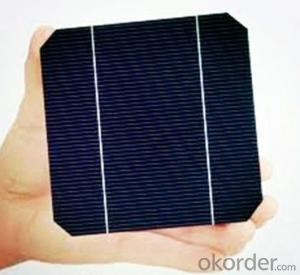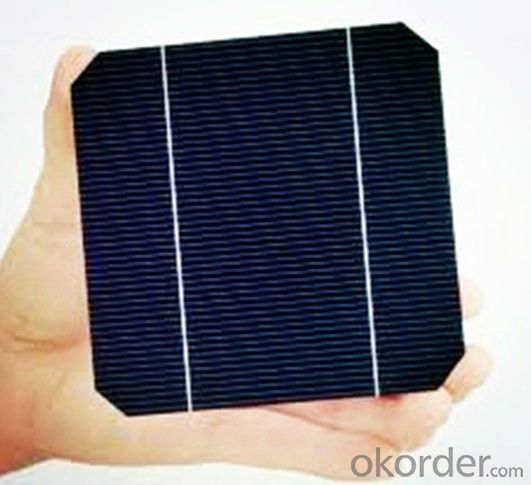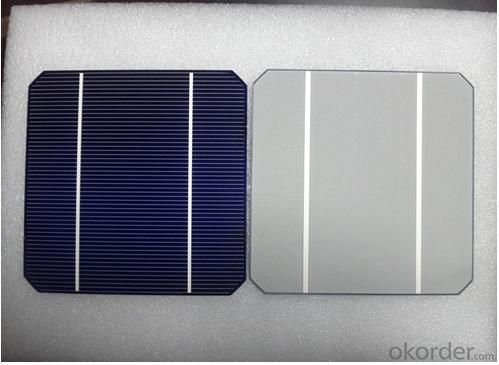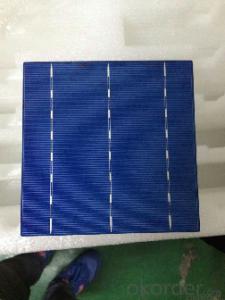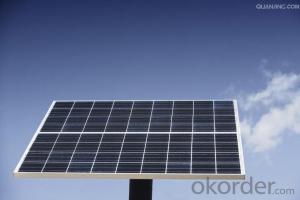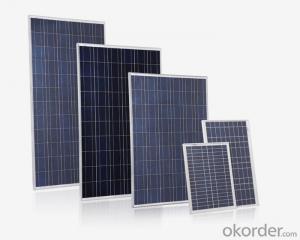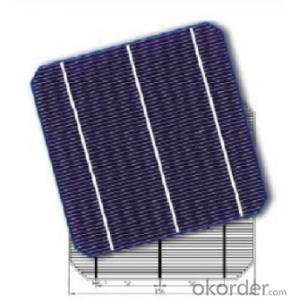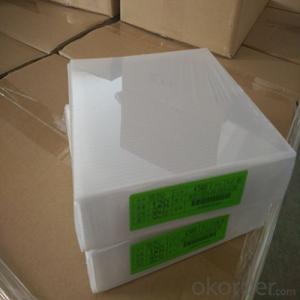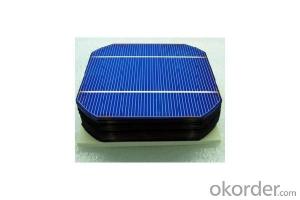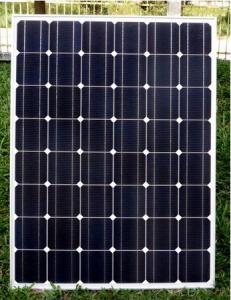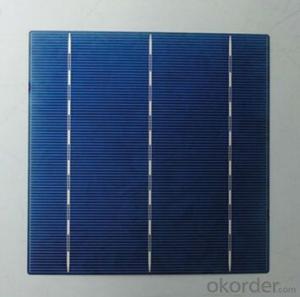Multi-Junction Solar Cells for Sale:Solar Cell Monocrystalline and Polycrystalline 156 with ISO9001/ISO14001/TUV/UL
- Loading Port:
- Shanghai
- Payment Terms:
- TT or LC
- Min Order Qty:
- 500 pc
- Supply Capability:
- 20000 pc/month
OKorder Service Pledge
OKorder Financial Service
You Might Also Like
| Packaging& Delivery | |
| Packaging Detail: | standard export package suitable for long seavoyage and tough handling |
| Delivery Detail: | 10-25 days depending on order quantity |
Specifications
solar cell for solar panel
1.16.8%~18.25% high efficiency
2.100% checked quality
3.ISO9001/ISO14001/TUV/UL
4.fast lead time
Our Advantage
1. High efficiency and High power.
2. Long-term electrical stability.
3. Lowest price and Fastest delivery.
4. Good quality and good service.
5.Bulk supply
6. Good Warranty
7.Big Sale
8.High quality
9.More than 35 years on the lifetime.
10 DHL/Fedex/UPS/TNT/EMS etc
Product Description
POLY6'(156*156) Multicrystalline Silicon solar celle
Diagonal: 220mm±0.5mm
Thickness(Si): 200±20 μm
Dimension: 156mm×156mm±0.5mm
Front(-) Back(+)
Blue anti-reflecting coating (silicon nitride); Aluminum back surface field;
1.5mm wide bus bars; 2.0mm wide soldering pads;
Distance between bus bars: 51mm. Distance between bus bars :51mm.
poly 156 cell Electrical Characteristics( solar cell for solar panel )
| Efficiency(%) | 18 | 17.8 | 17.6 | 17.4 | 17.2 | 16.8 | 16.6 | 16.4 | 16.2 | 16 | 15.8 | 15.6 |
| Pmpp(W) | 4.33 | 4.29 | 4.24 | 4.19 | 4.14 | 4.09 | 4.04 | 3.99 | 3.94 | 3.9 | 3.86 | 3.82 |
| Umpp(V) | 0.53 | 0.527 | 0.524 | 0.521 | 0.518 | 0.516 | 0.514 | 0.511 | 0.509 | 0.506 | 0.503 | 0.501 |
| Impp(A) | 8.159 | 8.126 | 8.081 | 8.035 | 7.99 | 7.938 | 7.876 | 7.813 | 7.754 | 7.698 | 7.642 | 7.586 |
| Uoc(V) | 0.633 | 0.631 | 0.628 | 0.625 | 0.623 | 0.62 | 0.618 | 0.617 | 0.615 | 0.613 | 0.611 | 0.609 |
| Isc(A) | 8.709 | 8.677 | 8.629 | 8.578 | 8.531 | 8.478 | 8.419 | 8.356 | 8.289 | 8.22 | 8.151 | 8.083 |
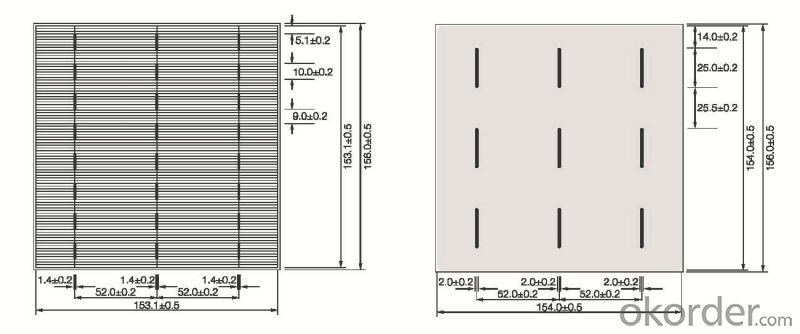
MONO6'(156*156) Monocrystalline silicon solar cell
Thickness(Si): 200±20 μm
Dimension: 156mm×156mm±0.5mm
Diagonal: 200mm±0.5mm (round chamfers)
Front(-) Back(+)
Blue anti-reflecting coating(silicon nitride); Aluminum back surface field;
1.3mm wide bus bars; 2.0mm wide soldering pads;
Distance between bus bars: 52mm. Distance between bus bars :52mm.
mono 156 Electrical Characteristics( solar cell for solar panel )
| Efficiency(%) | 20 | 19.2 | 19 | 18.8 | 18.6 | 18.4 | 18.2 | 18 | 17.8 | 17.6 | 17.4 | 17.2 |
| Pmpp(W) | 4.59 | 4.54 | 4.49 | 4.45 | 4.4 | 4.35 | 4.3 | 4.26 | 4.21 | 4.16 | 4.11 | 4.08 |
| Umpp(V) | 0.541 | 0.54 | 0.538 | 0.535 | 0.533 | 0.53 | 0.527 | 0.523 | 0.519 | 0.518 | 0.516 | 0.514 |
| Impp(A) | 8.484 | 8.407 | 8.346 | 8.318 | 8.255 | 8.208 | 8.159 | 8.145 | 8.112 | 8.031 | 7.95 | 7.869 |
| Uoc(V) | 0.64 | 0.639 | 0.638 | 0.637 | 0.636 | 0.634 | 0.632 | 0.631 | 0.63 | 0.629 | 0.628 | 0.627 |
| Isc(A) | 8.972 | 8.959 | 8.936 | 8.912 | 8.875 | 8.83 | 8.805 | 8.787 | 8.775 | 8.695 | 8.615 | 8.535 |
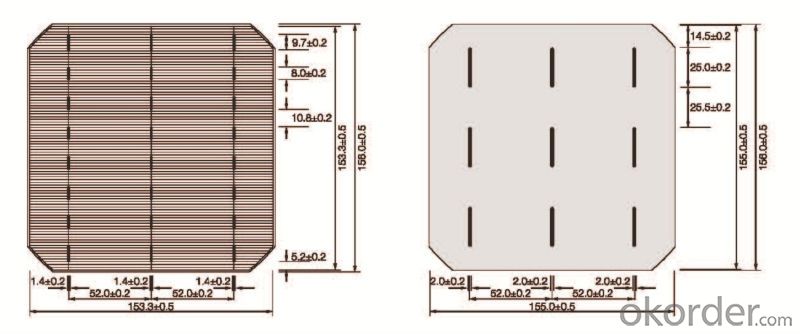
FAQ
1, What’s price per product ?
A: It’s depends on the quantity, delivery date and payment terms of the order. We can talk further about the detail price issue. Our products is high quality with lower price level.
2, How to make payment?
We accept T/T or L/C.
3, What is your lead time?
Generally 1-5 weeks depends on the order quantity and your specific requirements.
4, Can you do OEM for us?
Yes, we can.
5, How do you pack your products?
We have rich experience on how to pack the panels to make sure the safety on shipment when it arrives at the destination.
With the reduction of non-renewable energy sources, environmental pollution is worsening; people gradually increased the demand for renewable energy. Solar energy is a form of renewable energy, with rich resources and environmental advantages of clean, so that the solar cell has become the focus of research. Thin film solar cell price is low. The thin film solar cells with its low price, lightweight, low consumables and so much good low light response have obtained many researchers’ attention.
Brief introduction of Thin Film Solar Cell
First need to define the scope of the thin film solar cell, the solar cell is the first generation of single crystal or polycrystalline silicon cells, a second generation solar cells using a material having a large absorption coefficient, thickness of the cell not thick enough to absorb sunlight, so called thin film solar battery. Depending on the light-absorbing material, a common classification of thin film solar cells is: cadmium telluride (CdTe), copper indium gallium selenide (CIGS), dye-sensitized (DSSC) and organic polymers (OPV) solar cells. Various types of batteries are also being studied preparation process to reduce costs, so each type of cell production method is not unique.
Thin film solar cell is to be able to charge the battery through the solar thin film, which is generally the same with thin film thickness, usually black or dark. Mainly used in construction, military, travel, defense, power supply and other purposes.
Advantages of Thin Film Solar Cell
1. In low light the extent of its power generation performance is very good.
2. In the case of the same light intensity as compared with other batteries and less power loss.
3. The thin film solar cell has a very good power temperature coefficient.
4. The light transmission and generation capacity, only a small amount of silicon feedstock and the production time.
5. Internal short-circuit problem does not occur.
6. Volume thin film solar cells, generally raw materials, building materials, and can be integrated with the application.
- Q: How are solar cells used in spacecraft?
- Solar cells are used in spacecraft to convert sunlight into electricity, providing power to the various systems and instruments on board.
- Q: What is the role of grounding systems in solar cell systems?
- The role of grounding systems in solar cell systems is to provide a safe path for electrical currents to flow, ensuring the protection of both the solar panels and the users. Grounding systems help to dissipate any excess electrical energy, preventing damage to the system and reducing the risk of electrical shocks or fires. Additionally, grounding systems aid in the proper functioning of protective devices such as fuses and circuit breakers, allowing for quick detection and isolation of electrical faults. Overall, grounding systems play a crucial role in maintaining the safety and reliability of solar cell systems.
- Q: What is the role of solar cells in reducing carbon emissions?
- Solar cells play a crucial role in reducing carbon emissions by harnessing the power of sunlight to generate clean and renewable electricity. By converting sunlight directly into electricity, solar cells eliminate the need for burning fossil fuels, which are the primary source of carbon dioxide emissions. This clean energy source helps reduce our reliance on coal, oil, and natural gas, leading to a significant reduction in greenhouse gas emissions and combating climate change.
- Q: Can solar cells be used for indoor lighting?
- Yes, solar cells can be used for indoor lighting. However, it is important to note that solar cells require sunlight to generate electricity. To use solar cells for indoor lighting, additional equipment such as batteries or capacitors are needed to store the energy generated during daylight hours and power the lights when sunlight is not available.
- Q: How do solar cells handle hail or other severe weather conditions?
- Solar cells are designed to withstand severe weather conditions including hail. They are made with durable materials such as tempered glass that can handle impact from hailstones. Additionally, solar panels are tested and rated for their ability to withstand extreme weather events, ensuring their resilience in harsh conditions.
- Q: Can solar cells be used to power street lights?
- Yes, solar cells can be used to power street lights. Solar-powered street lights utilize photovoltaic panels to convert sunlight into electricity, which is then stored in batteries. This stored energy is used to power the street lights during the night, providing an eco-friendly and cost-effective lighting solution for public spaces.
- Q: What are the environmental impacts of solar cell production?
- The environmental impacts of solar cell production include the extraction of raw materials, such as silicon, which can contribute to deforestation and habitat destruction. The manufacturing process also requires a significant amount of energy, which may be sourced from fossil fuels and contribute to greenhouse gas emissions. Additionally, the disposal and recycling of solar panels can pose challenges, as some components contain harmful substances. However, it is important to note that the overall environmental benefits of solar energy, such as reduced greenhouse gas emissions and reliance on fossil fuels, outweigh these impacts.
- Q: How do solar cells perform in areas with frequent power outages?
- Solar cells can be a reliable source of electricity in areas with frequent power outages. Since solar cells generate electricity from sunlight, they are not dependent on the grid for power supply. This means that even during power outages, solar cells can continue to produce electricity as long as there is sufficient sunlight available. However, the performance of solar cells during cloudy or rainy days may be affected, resulting in reduced electricity generation. Additionally, to ensure uninterrupted power supply, it is advisable to use energy storage systems such as batteries in conjunction with solar cells in areas with frequent power outages.
- Q: How are solar cells different from solar panels?
- Solar cells are the individual units that convert sunlight directly into electricity, while solar panels are a collection of these cells that work together to generate a larger amount of power.
- Q: What is the impact of solar cells on job creation?
- The impact of solar cells on job creation is significant. The solar industry has seen a rapid growth in recent years, leading to a surge in job opportunities. Solar cell manufacturing, installation, maintenance, and research and development have all created a wide range of employment opportunities. This growth has not only created jobs in the renewable energy sector but has also generated indirect employment in related industries. Additionally, the shift towards solar energy has encouraged innovation and entrepreneurship, further contributing to job creation. Overall, solar cells have had a positive impact on job creation by driving economic growth and fostering a sustainable workforce.
Send your message to us
Multi-Junction Solar Cells for Sale:Solar Cell Monocrystalline and Polycrystalline 156 with ISO9001/ISO14001/TUV/UL
- Loading Port:
- Shanghai
- Payment Terms:
- TT or LC
- Min Order Qty:
- 500 pc
- Supply Capability:
- 20000 pc/month
OKorder Service Pledge
OKorder Financial Service
Similar products
Hot products
Hot Searches
Related keywords
